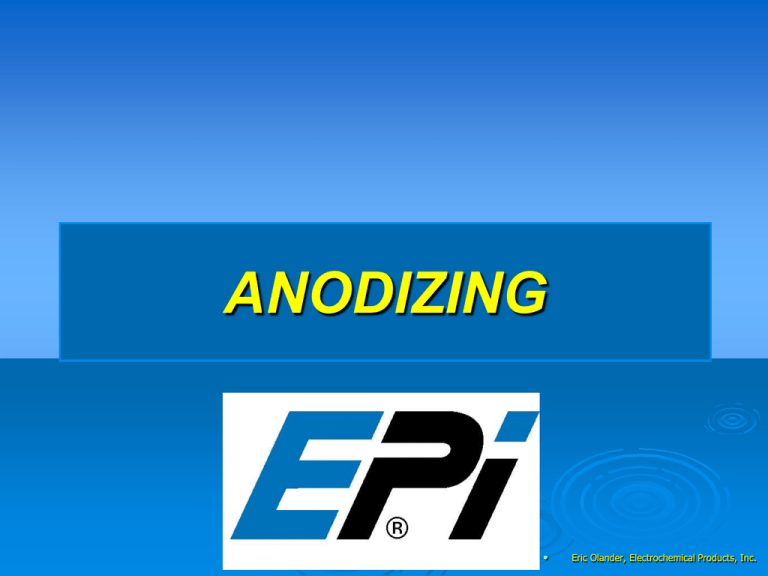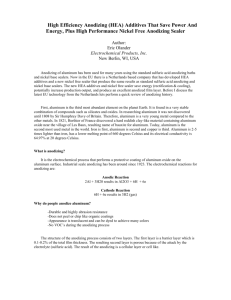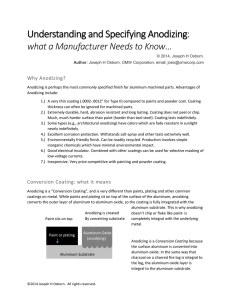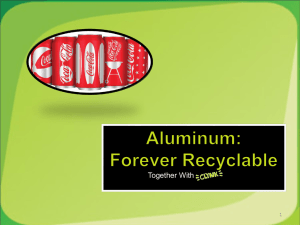Project: HEA - Electrochemical Products Inc.
advertisement

ANODIZING • Eric Olander, Electrochemical Products, Inc. Anodizing Anodizing History of Aluminum. 1821 P. Berthier (France) discovers a hard reddish clay-like material containing 52% aluminum oxide near the village of Les Baux (Bauxite) SO ALUMINUM IS A VERY YOUNG METAL NOW DAYS!!! History of Aluminum. Aluminum is the third most abundant element in the Earth’s crust. In nature it only exists in very stable combinations with other materials (particularly as silicates and oxides). It was not until 1808 that its existence was first established by Sir Humphry Davy (Britain) Aluminum production. Characteristics of Aluminum. Second most used metal in the world (First iron, second Aluminum, third copper). Aluminum has very good properties. So it is makes aluminum very attractive for many possibilities. Physical properties of Aluminum. Density of Melting Point EC* at 20ºC * Electrical conductivity 2.7 (iron is 2,5 x heavier). 660ºC. 64.94% What is Anodizing? Electrochemical process that forms a protective coating of Aluminum oxide on the Aluminum surface. The reaction in the anodizing process. The anode reaction: 2 Al (metal) + 3 H2O → Al2O3 (oxide coating) + 6H+ + 6e There is an oxidation process taking place on the “anode” surface (aluminum material). The cathode reaction: 6H+ + 6e → 3H2 (gas) There is a reduction process taking place on the cathode surface. Hydrogen gas is evolved at the cathode and appears as bubbles during the anodizing process. The total reaction. 2 Al (metal) + 3 H2O → Al2O3 (oxide coating) + 3H2 (gas)↑ Aluminum metal is oxidized (anodized), and hydrogen gas is evolved at the cathode. Anodizing benefits. Anodic coatings are highly abrasion-resistant an durable. Anodic coatings do not peel, chip etc. Anodic coatings are translucent, resulting in a deep, rich metallic appearance. Anodic coatings are scarcely affected by sunlight. Anodizing benefits. Anodic coatings are excellent finishes for areas subject to filiform corrosion. The anodizing process uses chemicals without VOC’s and aluminum is recyclable. Anodized aluminum can be colored in a full spectrum of shades. The anodic oxide coating. Consists of two layers. The porous thick outer layer growing on an inner layer which is thin and dense. • Thin layer is the barrier layer which is very thin (0.1 and 2.0% of the total film) • The outer layer is porous due to the attack from the electrolyte. The structure of a typical cell. Attack of the electrolyte. Parameters. Type and concentration electrolyte (Sulfuric acid) Temperature and agitation of the electrolyte. Time in the anodizing tank. Current density (A/dm²) Sulfuric acid electrolyte. Parameters. H2SO4 200 g/l ± 10 g/l Aluminum content < 20 g/l (5-10 g/l) Chloride content < 100 mg/l The acid concentration is only critical at high anodizing temperatures. High acid concentrations lower the anodizing voltage required (about 0.04 V per g/lH2SO4) Temperature. Parameters. H2SO4 bath: not above 21ºC H2SO4 bath + oxalic acid: not above 25ºC H2SO4 bath + Hardcoat 93: not above 27ºC Current density. Parameters. 1.2 – 2.0 A/dm2 (5-10 µm) 1.4 – 2.0 A/dm2 (15 µm) 1.5 – 2.0 A/dm2 (20-25 µm) Other important parameters to have a good anodization bath Cathodes surface (cathode-anode ratio must be 1:1.5 to 1:2.5). The distance between the cathode and the anode should not be less than 150 mm. Jigs submerged in the electrolyte must have a cross section representing more than 0.2 mm²/amp Other important parameters to have a good anodization bath Contacts must be sufficient to conduct the current evenly to all parts in the load and over the hole part. The cooling capacity of the system used must be capable of absorbing all heat generated during anodizing. Good agitation is essential to maintain constant temperature of the bath. Other steps prior to anodizing Alkaline Degreasing Rinse De-anodizing Alkaline etch Rinse Rinse Desmutting Rinse Anodization bath Anodization bath Rinse Rinse Electrocolor Rinse Rinse D.I. water Sealing Sealing AD-ANO CLEANER 219 AD-ANO ADDITION AL28 AD-ANO ADDITION Al 28 AD-ANO ADEOX 11 AD-ANO HARDCOAT 93 AD-ANO HARDCOAT 93 AD-ANO E-Color 200 AD-ANO FASTSEAL AD-ANO FASTSEAL Alkaline Degreasing AD-ANO CLEANER 219 • In the degreasing tank oil, grease, and other surface contamination is removed from the profile surface. • Conditions: Concentration Time Temperature Agitation pH : 3 - 5 % (30 - 50 g/l) : 5 - 15 minutes : 60 – 70°C : Air pressure or pumping the bath solution is necessary : 9.2 – 9.6 (to avoid degradation of aluminum pH 9.2 – 9.3) Rinse • Usually there is a rinsing step (or more) after each process step. Counter flow of the rinse water from the tank with the cleanest water to the tank with the most dirty water is normal. Agitation of the water is an advantage to get a better rinsing. De-anodizing / etching AD-ANO ADDITION AL28 • Aluminum has a thin natural oxide coating on the surface which has to be removed before the anodizing could start. • Conditions: Operating conditions decorative finishing Concentration caustic soda : 50 - 70 g/l Concentration AD Addition AL 28 : 15 - 20 g/l Aluminum content : 20 -150 g/l Temperature : 60 - 65C. Time : 6 - 15 minutes depending on required finish Operating conditions de-anodizing Concentration caustic soda Concentration AD Addition AL 28 Temperature Time : 90 - 120 g/l : 10 - 15 g/l : ambient : 8-15 minutes Desmutting AD-ANO ADEOX 11 • During the etching operation a black smut layer may be left on the aluminum surface. The smut is coming from the alloys in the aluminum. It consist of particles which are insoluble in the alkaline solution. • Conditions: AD-ANO ADEOX 11 H2SO4 : 20 - 30 g/l : 50 - 100 g/l Combined with nitric acid AD-ANO ADEOX 11 HNO3 : 25 - 30 g/l : 40 - 50 g/l Anodization AD-ANO HARDCOAT 93 It is recommended to use higher current density because of shorter times and less dissolving of aluminum. The obtained layers have a higher specific gravity. The advantages of AD-ANO HARDCOAT 91. • Anodizing at temperatures up to 30°C. and saving energy for cooling. Better conductivity caused by the higher temperature and saving energy for anodizing. Slower dissolution of aluminum, longer bath-life. Lower sulfuric acid concentration, less drag-out and saving chemicals for neutralizing. Conditions: Sulfuric acid concentration AD-ANO HARDCOAT 93 Aluminum concentration Temperature Current density : 140 - 160 g/l (150 g/l) : 20 - 30 g/l (30 g/l ) : 5 - 25 g/l : 25 - 30°C. : 1.2 - 1.8 A/dm2 Electrocolor AD-ANO E-COLOR 200 • Is a two step color anodizing process. Dyeing with metal salt and uses electric current. • Composition: AD-ANO Stannad L40 stabilizer Stannous sulphate 25 - 40 g/l 15 - 20 g/l Sulfuric acid 20 g/l Replenish with AD-ANO C200 ADII DI water De-ionized water is very important as rinse before sealing. Also the time of rinsing. Agitation of the water is an advantage to get a better rinsing. Sealing AD-ANO FASTSEAL • Sealing is one of the most important steps in the anodizing process. Sealing process influences wear and corrosion resistance, chemical resistance and color stability. • Condition: Concentrations AD-ANO Fastseal Start pH range Temperature Dipping time per micron Replenishing should be done with AD-ANO Fastseal Replenisher ME : 2 - 3 ml/l : 5.8 - 6.2 : 88 - 98 °C. : 2 - 3 minutes Save Energy Anodize at high temperature HEA H(high) E(ffinciency) A(nodizing) This technique makes it possible to produce an quality and perfect anodizing layer. The technique reduce the necessary working energy. Technology HEA New technology for anodizing systems. Benefits: Less energy consumption in anodizing Less energy consumption for cooling systems Efficient use of the plant installation Parameters that impacts quality of the anodizing layer Concentration and temperature of the Sulfuric acid Additives Residence time depends on the current density and layer thickness Efficient bath agitation and bath cooling Concentration Sulfuric Acid (standard = 150-220 g/l) The anodizing layer become weaker if the Sulfuric Acid concentration is to high. The abrasive resistance will be lower if the concentration Sulfuric Acid is to high. (Soft anodizing layer) Impact temperature of the electrolyte Higher temperatures: Anodizing layers with a lower density Difficult to close the pores in the anodizing layer because the layer is to soft. Easy to give the anodizing layer a color, but difficult to reproduce the color fastness (especially organic color systems) Low temperatures : Hard Anodizing layers Better abrasive resistance IMPACT of the current density Low current density: A longer residence time is necessary that caused degradation of the formed anodizing layer. Fast color procedure of the anodizing layer. IMPACT of the current density High current density: Fast layer structure More heat Perfect anodizing layer if there’s enough bath agitation and cooling. How can we impact the anodizing layer on a positive way? By reducing the Sulfuric Acid content. Improve the conductivity by using additives. Reduce aggressive impacts of the chemicals by using corrosion agents. Care a good bath agitation and bath cooling Anodizing conditions during the test Sulfuric Acid : Aluminium : Additives: Temperature: Current density : Layer thickness: 180 g/l 5 g/l HEA or Hardcoat 93 as indicated as indicated 20±1 micron Table 1-Voltage-trend of current density and temperature T A/dm2 16° C 19° C 22° C 25° C 30° C 1,0 A/dm2 17.7 15.6 14.5 13.2 11.1 1,5 A/dm2 19.6 18.0 16.8 15.5 13.7 2,0 A/dm2 21.1 19.0 18.4 17.4 15.5 3,0 A/dm2 22.1 21.0 20.3 19.3 18.1 4,0 A/dm2 23.0 21.9 21.2 20.0 18.8 6,0 A/dm2 23.9 22.9 22.6 21.6 20.3 Table 2- Anodizing at different current densities A/dm2 min./microns 1.0 Time (min.) for 20 microns 64 1.5 44 2.2 2.0 32 1.6 3.0 22 1.1 4.0 16 0.8 6.0 11 0.5 3.2 Table 3-Power consumption (kWh/m2) Temperature and current density variations T A/dm2 1.0 A/dm2 1.5 A/dm2 2.0 A/dm2 3.0 A/dm2 4.0 A/dm2 6.0 A/dm2 16° C 19° C 22° C 25° C 30° C 1.89 1.67 1.55 1.41 1.19 2.16 1.98 1.85 1.70 1.51 2.26 2.03 1.97 1.86 1.66 2.43 2.31 2.23 2.12 1.99 2.45 2.34 2.27 2.14 2.01 2.63 2.52 2.49 2.37 2.23 Summary: Current density A/dm2 Temperature Consumption Kwh/m2 1.5 19 ºC 1.98 1.5 25 ºC 1.70 +6 -0.28 Difference A production of 2000 m2/a day save 2000 x 0.28= 560 Kwh(= 14%) THAT’s 140000 Kwh a YEAR. Cost savings in $ Milwaukee WE Energies 0.19$/Kwh 140,000 x 0.19= $26,600 Use electricity saving you energy costs FOR EXAMPLE (practical experience) Anodizing at different temperatures (19 - 30°C) Temperature 19°C 25°C 30°C Current density Amp./m2 150 150 150 Voltage 18 volt 15.5 volt 13.7 volt Procestime 45 min 45 min 45 min Bath conditions: H2SO4 (g/l) Aluminium (g/l) Additive (g/l) 180 5 – 15 None 160 5 – 20 20 Hardcoat 93 160 5 – 20 35 HEA Energy anodizing at higher temperatures U=IXA Consumption a hour = • voltage x amperage x time. Consumption/m² = 19°C • 18 (V) x 150 (A) x 45/60 (time) = 2025 watt 25°C • 15.5 (V) x 150 (A) x 45/60 (time) = 1744 watt 30°C • 13.7 (V) x 150 (A) x 45/60 (time) = 1541 watt The advantage obtained in watts per m². At 25°C en 150 Amp: 2025 - 1744 = 281 watt (14%) less consumption required for the formation of the anodizing layer. Bij 30°C en 150 Amp: 2025 - 1541 = 484 watt (24%) less consumption required for the formation of the anodizing layer. • Note: also for bath cooling there will be a significantly consumption benefit because the delta Temperature is larger. Increase production capacity by producing larger charges. - You can increase the production with 14%, because the current density will be equal to normal anodizing procedures. Anodizing at higher temperature (25 - 30°C) and higher current density. Temperature 19°C 25°C 30°C Current density Amp./m2 150 180 180 Voltage 18 volt 16.6 volt 14.8 volt 36 min 36 min 160 5 – 20 20 Hardcoat 93 160 5 – 20 35 HEA Time Bath conditions H2SO4 (g/l) Aluminium (g/l) Additive (g/l) 45 min 180 5 – 15 None Consumption Energy at higher temperature and higher current density. Consumption/m² = 19°C = 2025 watt 25°C • 16.6 (V) x 180 (A) x 36/60 (time) = 1793 watt 30°C • 14.8 (V) x 180 (A) x 36/60 (time) = 1598 watt The advantage obtained in watts per m². At 25°C and 180 Amp: 2025 - 1793 = 232 watt (11,5%) less consumption required for the formation of the anodizing layer. Bij 30°C en 180 Amp: 2025 - 1598 = 427 watt (21%) less consumption required for the formation of the anodizing layer • Note: also for bath cooling there will be a significantly consumption benefit because the delta Temperature is larger. Conclusion: How to use this technology: •If the rectifier capacity is already fully exploited: Only consumption saving of cooling and production If the rectifier capacity is not already fully exploited: • Consumption saving of cooling and production. More production capacity is possible. • Eric Olander, Electrochemical Products, Inc.





